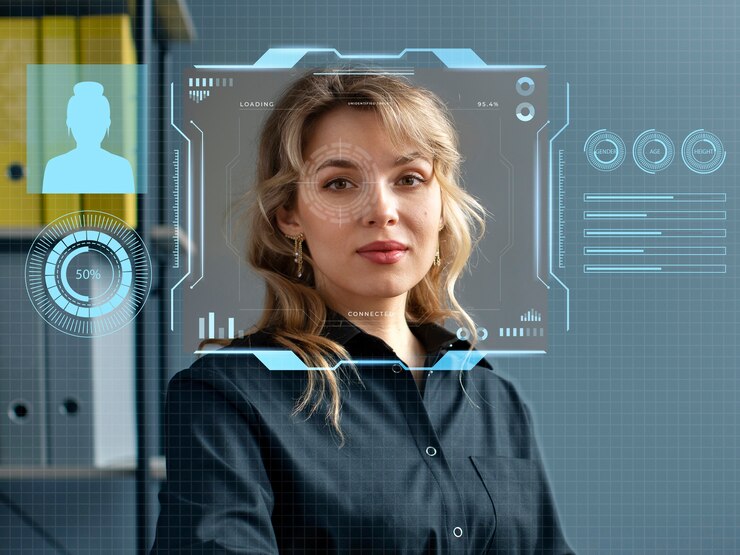Face recognition tools include OpenCV, Dlib, Face Net, and Microsoft Azure Face API. These tools use algorithms to identify and verify individuals based on their facial features.
Face recognition technology has significantly advanced in recent years, enabling various industries to leverage its benefits. From enhancing security systems to improving user experience in mobile devices, the applications of face recognition tools are widespread. OpenCV, an open-source computer vision and machine learning software library, offers robust face detection and recognition capabilities.
Similarly, Dlib provides facial feature extraction and recognition functionality. FaceNet, a deep learning facial recognition system, uses neural networks to generate face embeddings for matching faces. Microsoft Azure Face API is a cloud-based tool that offers facial recognition and emotion detection services. These tools play a crucial role in developing efficient and accurate face recognition systems across different domains.
The Basics Of Face Recognition
Face recognition is a powerful technology that has gained significant importance in various industries. It involves identifying or verifying a person’s identity by analyzing and comparing patterns based on the person’s facial features. This process relies on the use of specialized tools and algorithms that enable advanced facial recognition capabilities.
Understanding The Principle
In its essence, face recognition works by capturing an individual’s facial features, such as the distance between the eyes and the shape of the face, and converting them into data. This data is then compared against a database of known faces to determine a match. The principle behind face recognition is based on pattern recognition, machine learning, and artificial intelligence algorithms.
Role Of Face Recognition Tools
The tools used in face recognition play a crucial role in the accuracy and efficiency of the process. These tools encompass a wide range of technologies, including facial detection, feature extraction, and matching algorithms. Facial detection tools are responsible for locating and identifying a face within an image or video frame, while feature extraction tools analyze the unique characteristics of an individual’s face. Matching algorithms then compare these features to known faces to make an identification.
Importance Of Tools In Face Recognition
The significance of tools in face recognition cannot be understated. They are instrumental in overcoming challenges such as variations in lighting, facial expressions, and aging, thereby enhancing the reliability of the recognition process. Additionally, these tools enable face recognition to be applied across diverse applications, including security, access control, and personalized user experiences.
Types Of Tools In Face Recognition
When it comes to face recognition technology, various tools and algorithms play a crucial role in enabling accurate and efficient detection and recognition of human faces. Understanding the different types of tools in face recognition is essential for grasping the complexity and functionality of this advanced technology.
Facial Detection Tools
Facial detection tools are an essential component of face recognition systems, as they are responsible for identifying and locating human faces within images or video streams. These tools use sophisticated algorithms to analyze visual data and detect facial features, such as eyes, nose, and mouth, with a high degree of accuracy.
Role Of Facial Detection Algorithms
Facial detection algorithms are the underlying mechanisms that power facial detection tools. They leverage machine learning and computer vision techniques to distinguish between different facial features and patterns, enabling precise identification and localization of human faces in diverse environments and conditions.
Facial Recognition Software
Facial recognition software integrates facial detection and identification capabilities to match detected faces against a database of known individuals. These software solutions employ advanced algorithms to compare facial features and determine the identity of a person, making them invaluable for security, authentication, and access control applications.
Advantages And Limitations
- Advantages: Increased security, enhanced user experience, and efficient identity verification.
- Limitations: Privacy concerns, potential algorithmic bias, and susceptibility to environmental factors.
3d Face Reconstruction Tools
3D face reconstruction tools utilize depth-sensing technologies to create three-dimensional models of human faces, offering enhanced accuracy and robustness in facial recognition applications. These tools are capable of capturing detailed facial geometry and texture, enabling precise identification and authentication.
Applications And Accuracy
- Security and Surveillance Systems
- Access Control and Attendance Tracking
- Criminal Investigations and Law Enforcement
- Accuracy: High accuracy in controlled environments, but potential challenges in adverse lighting and occlusions.
Key Features Of Face Recognition Tools
Face recognition tools are equipped with advanced features that enable accurate and efficient identification and analysis of facial data. These tools leverage cutting-edge technologies, such as machine learning and deep learning, to deliver robust capabilities for various applications. Let’s delve into the key features of face recognition tools, highlighting their data preprocessing capabilities, machine learning algorithms, deep learning for facial analysis, and their integration with surveillance systems.
Data Preprocessing Capabilities
Face recognition tools feature robust data preprocessing capabilities, allowing for the extraction and normalization of facial features from diverse sources. These tools employ techniques such as facial landmark detection, image alignment, and quality assessment to ensure the accuracy and consistency of input data.
Machine Learning Algorithms For Face Recognition
Utilizing advanced machine learning algorithms, face recognition tools can effectively learn from labeled datasets to perform facial recognition tasks. These algorithms include support vector machines, k-nearest neighbors, and decision trees, enabling the tools to achieve high accuracy in identifying and verifying individuals based on their facial characteristics.
Deep Learning For Facial Analysis
Face recognition tools harness the power of deep learning frameworks, such as convolutional neural networks (CNNs), for comprehensive facial analysis. This enables the tools to detect intricate patterns and variations in facial features, enhancing their capability to perform complex tasks such as facial expression recognition and age estimation with remarkable precision.
Integration With Surveillance Systems
Face recognition tools seamlessly integrate with surveillance systems, enabling real-time facial recognition and tracking within security and access control environments. Through the integration of video analytics and facial recognition technologies, these tools enhance the monitoring and identification of individuals in diverse settings.
Applications In Security And Access Control
Facial recognition tools find extensive applications in security and access control systems, contributing to enhanced security measures in various domains such as airports, banks, and government facilities. These tools facilitate swift and accurate identification of authorized personnel, thereby bolstering the efficiency and reliability of access control mechanisms.
Advances In Face Recognition Technology
Advances in Face Recognition Technology have led to the development of cutting-edge tools and techniques that are revolutionizing the fields of security, authentication, and personalization. As organizations and individuals continue to prioritize the importance of facial recognition technology, the tools used in this domain have seen significant advancements.
Emerging Trends In Face Recognition Tools
The field of face recognition technology is witnessing rapid evolution, with emerging trends shaping the development of innovative tools. Advancements such as 3D face recognition, deep learning algorithms, and edge computing are revolutionizing the capabilities of face recognition tools.
Biometric Authentication In Mobile Devices
The integration of face recognition technology for biometric authentication in mobile devices represents a significant leap in user security and convenience. Tools such as liveness detection and anti-spoofing mechanisms are enhancing the reliability of facial recognition for mobile authentication, ensuring a seamless and secure user experience.
Artificial Intelligence In Face Recognition
Artificial intelligence (AI) plays a pivotal role in the advancement of face recognition tools. Machine learning algorithms, neural networks, and facial feature extraction techniques powered by AI are driving the accuracy and efficiency of facial recognition systems, leading to enhanced performance and reliability.
Potential For Future Development
The potential for future development in face recognition tools is immense, with ongoing research and technological innovations paving the way for unprecedented advancements. Areas such as emotion recognition, facial expression analysis, and multi-modal biometrics hold promise for the future development of face recognition tools, driving the expansion of their applications across various domains.
Ethical Considerations In Face Recognition
Ethical considerations in face recognition technology have become a subject of intense debate in recent years. As the use of facial recognition tools becomes more widespread, it is essential to address the privacy concerns, regulatory challenges, and the impact of these technologies on society. Responsible use of face recognition technology requires a delicate balance between security and privacy requirements. Let’s explore these ethical considerations in more detail.
Privacy Concerns And Regulatory Challenges
Privacy concerns surrounding face recognition tools are a significant issue. The collection, storage, and potential misuse of facial data raise fundamental questions about individual privacy and consent. Regulatory challenges emerge as policymakers struggle to keep pace with the rapid advancement of facial recognition technology, leading to an inconsistent legal landscape and a lack of clear guidelines.
Impact Of Face Recognition Tools On Society
The impact of face recognition tools on society is multifaceted. While these tools offer enhanced security measures and convenience, they also raise concerns about mass surveillance, infringement of civil liberties, and potential biases in algorithmic decision-making. Understanding the broader societal implications of facial recognition technology is crucial in shaping its ethical use.
Responsible Use Of Face Recognition Technology
Encouraging the responsible use of facial recognition technology necessitates establishing transparent policies for data collection, promoting ethical standards for algorithm development, and ensuring the protection of individual rights and privacy. Integrating ethical considerations into the design and deployment of face recognition tools is essential to mitigate potential harms.
Balancing Security And Privacy Requirements
Achieving a balance between robust security measures and individual privacy requirements is a complex undertaking. Striking this balance necessitates comprehensive risk assessments, clear governance frameworks, and continuous monitoring to ensure that facial recognition technologies are employed in a manner that respects privacy rights while addressing security imperatives.

Credit: truthout.org
Frequently Asked Questions Of What Are The Tools Used In Face Recognition?
What Are The Tools Used In Face Recognition System?
The tools used in face recognition systems include cameras, sensors, software algorithms, and databases. These tools work together to capture and process facial images for identification and authentication.
What Technologies Are Used In Facial Recognition?
Facial recognition technology uses algorithms for analysis. It often includes machine learning, neural networks, and deep learning. Also, it utilizes image processing to identify and verify faces.
What Are The Techniques Used In Face Recognition?
Face recognition techniques include feature extraction, such as eyes, nose, mouth, and analyzing their spatial relationships. Other methods involve machine learning algorithms to match patterns and identify unique facial features for accurate recognition. These techniques are employed to create robust and reliable face recognition systems.
What Is The Ai Tool To Detect Faces?
The AI tool to detect faces is called Face recognition system. It uses advanced algorithms to identify and analyze facial features.
Conclusion
Face recognition technology has evolved to provide a variety of tools for accurate identification. Whether it’s facial detection, verification, or analysis, these tools enable advanced security and convenience. By understanding the capabilities of these tools, businesses and industries can effectively utilize face recognition technology to enhance their operations and services.

